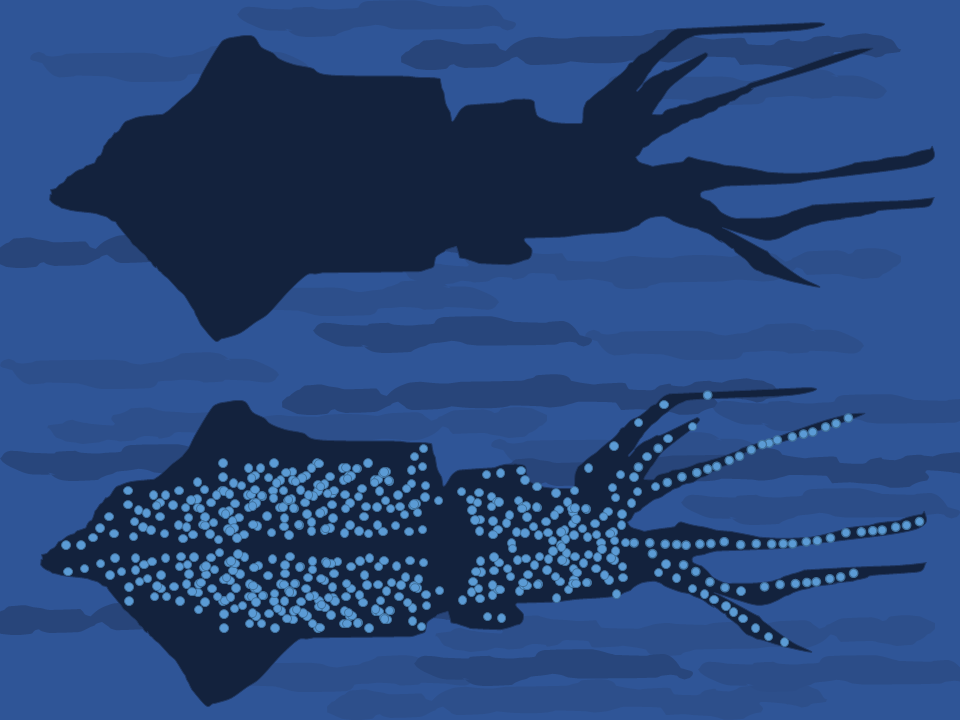|
Photophore
A photophore is a glandular organ that appears as luminous spots on various marine animals, including fish and cephalopods. The organ can be simple, or as complex as the human eye; equipped with lenses, shutters, color filters and reflectors, however unlike an eye it is optimized to produce light, not absorb it. The bioluminescence can variously be produced from compounds during the digestion of prey, from specialized mitochondrial cells in the organism called photocytes ("light producing" cells), or, similarly, associated with symbiotic bacteria in the organism that are cultured. The character of photophores is important in the identification of deep sea fishes. Photophores on fish are used for attracting food or for camouflage from predators by counter-illumination. Photophores are found on some cephalopods including the firefly squid, which can create impressive light displays, as well as numerous other deep sea organisms such as the pocket shark Mollisquama mississipp ... [...More Info...] [...Related Items...] OR: [Wikipedia] [Google] [Baidu] |
Counter-illumination
Counter-illumination is a method of active camouflage seen in marine animals such as firefly squid and midshipman fish, and in military prototypes, producing light to match their backgrounds in both brightness and wavelength. Marine animals of the mesopelagic (mid-water) zone tend to appear dark against the bright water surface when seen from below. They can camouflage themselves, often from predators but also from their prey, by producing light with bioluminescent photophores on their downward-facing surfaces, reducing the contrast of their silhouettes against the background. The light may be produced by the animals themselves, or by symbiotic bacteria, often '' Aliivibrio fischeri''. Counter-illumination differs from countershading, which uses only pigments such as melanin to reduce the appearance of shadows. It is one of the dominant types of aquatic camouflage, along with transparency and silvering. All three methods make animals in open water resemble their envir ... [...More Info...] [...Related Items...] OR: [Wikipedia] [Google] [Baidu] |
Firefly Squid
The firefly squid (''Watasenia scintillans''), also commonly known as the sparkling enope squid or hotaru-ika in Japan, is a species of squid in the family Enoploteuthidae. It is the sole species in the monotypic genus ''Watasenia''. These tiny squid are found on the shores of Japan in springtime during spawning season, but spend most of their lives in deeper waters between . They are bioluminescent organisms and emit blue light from photophores, which some scientists have hypothesized could be used for communication, camouflage, or attracting food, but it is still unclear in the scientific community exactly how this species uses their bioluminescence. The firefly squid is a predator and actively hunts its food, which includes copepods, small fish, and other squids. The lifespan of a firefly squid is about one year. At the end of their lives females return close to shore to release their eggs, and then die shortly thereafter. This mass migration of firefly squid to the shore is a l ... [...More Info...] [...Related Items...] OR: [Wikipedia] [Google] [Baidu] |
Bioluminescence
Bioluminescence is the production and emission of light by living organisms. It is a form of chemiluminescence. Bioluminescence occurs widely in marine vertebrates and invertebrates, as well as in some fungi, microorganisms including some bioluminescent bacteria, and terrestrial arthropods such as fireflies. In some animals, the light is bacteriogenic, produced by symbiotic bacteria such as those from the genus '' Vibrio''; in others, it is autogenic, produced by the animals themselves. In a general sense, the principal chemical reaction in bioluminescence involves a light-emitting molecule and an enzyme, generally called luciferin and luciferase, respectively. Because these are generic names, luciferins and luciferases are often distinguished by the species or group, e.g. firefly luciferin. In all characterized cases, the enzyme catalyzes the oxidation of the luciferin. In some species, the luciferase requires other cofactors, such as calcium or magnesium ions, and s ... [...More Info...] [...Related Items...] OR: [Wikipedia] [Google] [Baidu] |
Deep Sea Fish
Deep-sea fish are fish that live in the darkness below the sunlit surface waters, that is below the epipelagic or photic zone of the sea. The lanternfish is, by far, the most common deep-sea fish. Other deep sea fishes include the flashlight fish, cookiecutter shark, bristlemouths, anglerfish, viperfish, and some species of eelpout. Only about 2% of known marine species inhabit the pelagic environment. This means that they live in the water column as opposed to the benthic organisms that live in or on the sea floor. Deep-sea organisms generally inhabit bathypelagic (1000–4000m deep) and abyssopelagic (4000–6000m deep) zones. However, characteristics of deep-sea organisms, such as bioluminescence can be seen in the mesopelagic (200–1000m deep) zone as well. The mesopelagic zone is the disphotic zone, meaning light there is minimal but still measurable. The oxygen minimum layer exists somewhere between a depth of 700m and 1000m deep depending on the place in the ocean. T ... [...More Info...] [...Related Items...] OR: [Wikipedia] [Google] [Baidu] |
Histioteuthis Heteropsis
''Histioteuthis heteropsis'' (''H. heteropsis''), also known as the strawberry squid, is a species of small cock-eyed squid. The scientific nomenclature of these squid stems from their set of differently sized eyes, one being small and blue and the other being large and yellow. It is thought that the large eye is used to see objects against dim light, while the smaller eye is more able to view bioluminescent light sources. The squid’s vernacular name arose due to its rich red skin pigmentation and the presence of photophores along its body, making it appear like a strawberry with seeds. ''H. heteropsis'' live in the ocean’s mesopelagic zone and are found in the California Current and the Humboldt Current. Little is known about their specific feeding and mating behaviors, although their inking patterns have been subject to study. They are not easily disturbed, and only ink when provoked. ''H. heteropsis'' was discovered by Berry in 1913 and exhibited publicly for the first t ... [...More Info...] [...Related Items...] OR: [Wikipedia] [Google] [Baidu] |




